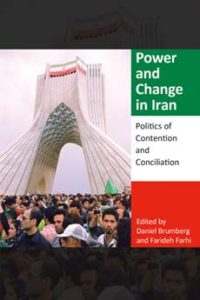Fresh protests broke out in Iran today as shop keepers, stall vendors, farmers and truck drivers demonstrated in the Amir-Kabir industrial complex of Isfahan, central Iran, protesting against high prices as the value of Tehran’s currency, the rial, plummets. Scores of demonstrators can be seen gathering in public squares and at the side of main roads, chanting “death to high prices” and “No to Gaza, no to Lebanon, my life for Iran,” according to reports.
 Tehran-based economist Saeed Leilaz criticized the government for not taking stronger measures, saying it “suffers from horrible inaction and absence of decision making.”
Tehran-based economist Saeed Leilaz criticized the government for not taking stronger measures, saying it “suffers from horrible inaction and absence of decision making.”
“People’s concerns are very reasonable in the existing conditions,” he told The Associated Press. “They are protecting their own interests by converting their rials to foreign currencies or gold coins.”
Suggestions that the US is ready to re-negotiate with the Islamic Republic will prompt alarm amongst the regime’s opponents, says Alireza Nader, an Iran expert who has supported the Trump administration’s pressure campaign
“This will increase fears among Iran’s opposition that the U.S. is willing to abandon them in return for a new nuclear deal,” he told POLITICO.
 Other observers fear that renewed hostility would only strengthen Iran’s elite Islamic Revolutionary Guard Corps and suffocate the country’s working and middle class when the U.S. should be taking measures to “engage Iran economically … to strengthen civil society, the democratic movement and the middle class, and weed out the theocracy.”
Other observers fear that renewed hostility would only strengthen Iran’s elite Islamic Revolutionary Guard Corps and suffocate the country’s working and middle class when the U.S. should be taking measures to “engage Iran economically … to strengthen civil society, the democratic movement and the middle class, and weed out the theocracy.”
The protesters’ grievances go beyond the economy, note analysts Dror Michman and Yael Mizrahi-Arnaud: Some protestors are concerned with civil rights and religious restrictions, specifically the law requiring women to wear hijabs, they write for Brookings:
These coalesced into what became known as “Girls of the Revolution Street” protests, where several women in Tehran and Isfahan took to the streets, removed their headscarves, and waved them in the air like flags. This civil disobedience exposes the heart of a debate which questions the core identity of the 1979 Islamic revolution, and the disappointed spaces of individual freedoms where many feel Rouhani failed to deliver.
 Elements of Iran’s civil society, notably the student movement, have experience in cultivating the pluralist coalitions required to nurture a sustainable democracy, says Ali Afshari (above), a former fellow at the National Endowment for Democracy, in an interview with Tavaana, Iran’s premier civic education and civil society capacity building initiative.
Elements of Iran’s civil society, notably the student movement, have experience in cultivating the pluralist coalitions required to nurture a sustainable democracy, says Ali Afshari (above), a former fellow at the National Endowment for Democracy, in an interview with Tavaana, Iran’s premier civic education and civil society capacity building initiative.
The National Interest’s Curt Mills presents an alternative scenario to peaceful regime change.
“What if the protests go on for years, to no avail? Or worse, what if, in order to survive, the regime turns its formidable Revolutionary Guards and Quds Force, as well as the countless militias across the Middle East whose loyalties it commands, on the Iranian people?”







